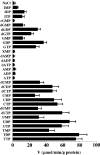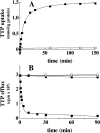Identification of a mitochondrial transporter for pyrimidine nucleotides in Saccharomyces cerevisiae: bacterial expression, reconstitution and functional characterization
- PMID: 16194150
- PMCID: PMC1360694
- DOI: 10.1042/BJ20051284
Identification of a mitochondrial transporter for pyrimidine nucleotides in Saccharomyces cerevisiae: bacterial expression, reconstitution and functional characterization
Abstract
Pyrimidine (deoxy)nucleoside triphosphates are required in mitochondria for the synthesis of DNA and the various types of RNA present in these organelles. In Saccharomyces cerevisiae, these nucleotides are synthesized outside the mitochondrial matrix and must therefore be transported across the permeability barrier of the mitochondrial inner membrane. However, no protein has ever been found to be associated with this transport activity. In the present study, Rim2p has been identified as a yeast mitochondrial pyrimidine nucleotide transporter. Rim2p (replication in mitochondria 2p) is a member of the mitochondrial carrier protein family having some special features. The RIM2 gene was overexpressed in bacteria. The purified protein was reconstituted into liposomes and its transport properties and kinetic parameters were characterized. It transported the pyrimidine (deoxy)nucleoside tri- and di-phosphates and, to a lesser extent, pyrimidine (deoxy)nucleoside monophosphates, by a counter-exchange mechanism. Transport was saturable, with an apparent K(m) of 207 microM for TTP, 404 microM for UTP and 435 microM for CTP. Rim2p was strongly inhibited by mercurials, bathophenanthroline, tannic acid and Bromocresol Purple, and partially inhibited by bongkrekic acid. Furthermore, the Rim2p-mediated heteroexchanges, TTP/TMP and TTP/TDP, are electroneutral and probably H+-compensated. The main physiological role of Rim2p is proposed to be to transport (deoxy)pyrimidine nucleoside triphosphates into mitochondria in exchange for intramitochondrially generated (deoxy)pyrimidine nucleoside monophosphates.
Figures




References
-
- Palmieri F. The mitochondrial transporter family (SLC25): physiological and pathological implications. Pflueger's Arch. 2004;447:689–709. - PubMed
Publication types
MeSH terms
Substances
LinkOut - more resources
Full Text Sources
Molecular Biology Databases

